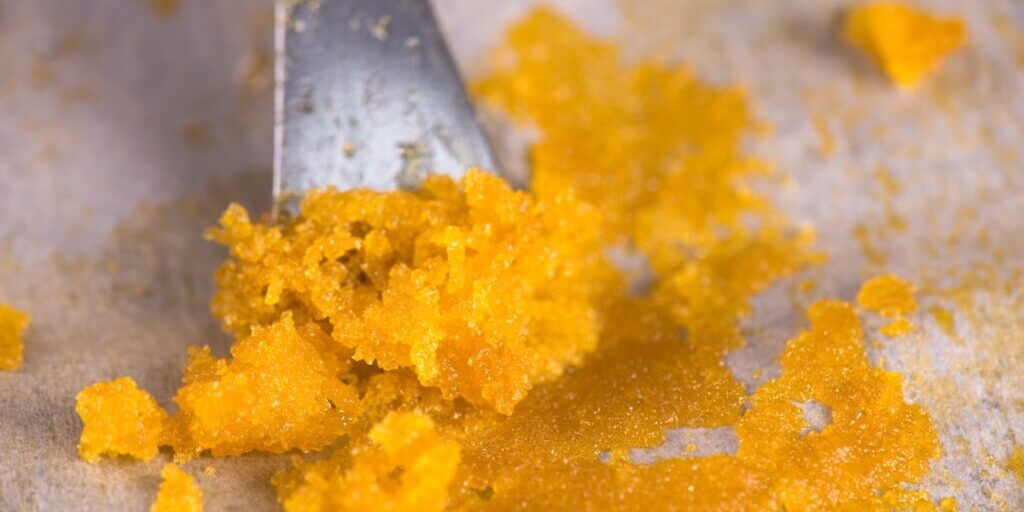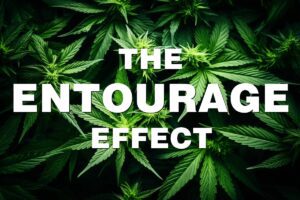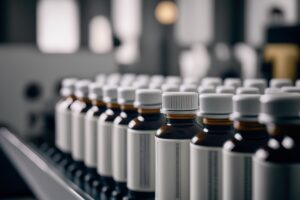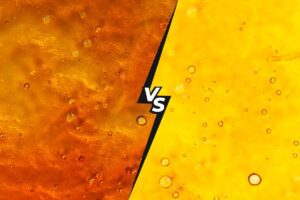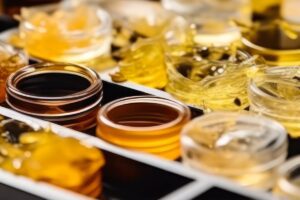Hemp extraction methods are everything when it comes to making high-quality CBD rich in bioactive compounds like cannabinoids, terpenes, and flavonoids. These powerful plant medicines work together in an entourage effect that amplifies the individual benefits of the active ingredient CBD.
According to research, different methods of extraction yield very different results. For example, the extraction procedure and solvent significantly affect the end product’s cannabinoid content and therapeutic potential. That’s why knowing where your CBD comes from and how the extract was made is essential!
Why does CBD need to be extracted?
All the good stuff in hemp plants is locked away inside tiny glands called trichomes. They cover the entire plant and are incredibly prolific in the flowering buds. Trichomes produce a thick, sticky resin that’s absolutely loaded with medicinal plant compounds like CBD, CBG, and CBN.

Hemp extraction unlocks these medicinal plant compounds from the harvested material into a superconcentrated raw full spectrum extract form. This extract can make a range of CBD products, from distillates and isolates to oil tinctures, softgels, honey sticks, topicals, and more!
How do different extraction methods work?
CBD extraction needs two main components to work: cannabis plants and a special solvent that dissolves the raw plant matter, releasing the natural medicines inside. The three most popular solvents are alcohol, carbon dioxide (CO2) gas, and hydrocarbons like butane or propane.
Different methods of extraction involve specialized techniques honed over years of trial and error, each with its advantages and disadvantages. Some CBD extraction methods, for example, are better at extracting natural hemp medicines from cannabis plants without damaging volatile compounds like terpenes in the process. High temperature and high pressure conventional methods of extraction destroy these fragile compounds, which may reduce the overall effectiveness of your finished CBD product.
Volatile compounds and essential oils are especially important in your CBD because they may boost its therapeutic potential through the entourage effect phenomenon. You can think of the entourage effect as a harmonious collaboration of all the cannabis plant medicines working together for a fuller, more therapeutic experience than any could offer alone. The best full spectrum CBD extract offers a diverse amount of minor cannabinoids like CBG, CBN, and CBDV, along with lots of terpenes, flavonoids, and polyphenols for maximum benefit.
Let’s explore the three main solvent extraction methods to learn more about how they work and the type of CBD end products they make.
Ethanol alcohol extraction
Ethanol extractions are made by submerging raw hemp plant material into a polar solvent. The process takes advantage of the fact that ethanol can bond with water-soluble and fat-soluble compounds. This unique characteristic allows ethanol to extract a wide range of chemical components from medicinal plants like hemp.
Ethanol-derived CBD extracts sometimes get a bad rap because not all manufacturers choose high-quality organic food-grade solvents. Denatured or isopropyl alcohol (IPA) are cheaper substitutes. Neither is considered safe for food use, so you should avoid extracts made using them.
Cannabiva brand true full spectrum CBD is produced using a USDA-organic certified food-grade ethanol extraction solvent made from organically-grown, non-GMO sugar cane. Our raw cannabis extracts are safe for people and pets, and they are always verified through independent 3rd-party lab testing.
Subzero and ambient extraction are the two types of ethanol extractions used to draw out the beneficial compounds from cannabis. Both ways are effective, but the subzero process ensures the most complete cannabinoid profile and best entourage benefit.
Let’s find out why sub zero is the way to go for CBD extraction.
Subzero CBD extraction
Subzero techniques produce winning true full spectrum CBD extracts every time!
First, whole cannabis plants are carefully hand-harvested, immediately flash-frozen, and kept on ice until it’s time for extraction. The deep freeze instantly preserves the delicate balance of plant medicines inside cannabis flower trichomes. During extraction, the hemp plant biomass stays at subzero temperatures. This specialized process offers a near-perfect phytochemical transfer from the cannabis to the extract. Phytochemicals are the plant power in your CBD and include cannabinoids, terpenes, flavonoids, and polyphenols working together for maximum entourage effects.
Subzero CBD extraction is superior to every other method for five key reasons:
Minimally processed for maximum benefits
Generally, the less a solvent or mechanical process touches the plant biomass, the better. Cannabiva’s subzero extraction procedure so efficiently draws out the beneficial compounds from raw hemp that it only requires a single pass of solvent. This minimal contact with the cannabis plant matter protects the fragile phytochemicals and preserves the plant’s unique cannabinoid profile. The end result is a 61-70% pure CBD extract that’s absolutely loaded with minor cannabinoids, terpenes, and secondary active compounds. Most other methods require an initial extraction followed by a “winterization” process to remove any unwanted chlorophyll, lipids, and waxes.
Made from hand-harvested, whole-plant cannabis
Organically grown whole cannabis sativa plants are harvested by hand and immediately flash-frozen to protect their cannabinoid profile and terpene content. The plants are kept on ice until they are ready for subzero extraction, with the essential natural medicines perfectly preserved inside the delicate flowers. CO2 and hydrocarbon extraction methods do not use whole cannabis material. Instead, they require the plant to be mechanically ground into a coarse to fine powder form. The process results in a 50% or greater loss of terpenes and other volatile compounds that, according to one scientific study, may yield an entirely different end product.
No pressure process is gentle on the extract
We use a vacuum system and falling film process to protect the cannabinoid profile and terpene content of our raw CBD extracts. Too much pressure or excessively high temperatures — as you’ll commonly find in CO2 extraction and hydrocarbon methods — will tear the terpenes from the plant matter and damage the integrity of the finished product. Our “no pressure” extraction technique protects the most delicate natural medicines throughout the process, so you always get a virtually perfect copy of the original cannabis plant’s phytochemical profile.
More minor cannabinoids in every batch
Enjoy more essential minor cannabinoids like CBG, CBN, CBC, and CBDV when you choose Cannabiva brand CBD. Our entire manufacturing process is engineered to preserve the natural cannabis medicines from start to finish, ensuring you get CBD extracts that are chockful of all the good stuff you need to feel better.
Versatile and ready for use in your favorite CBD products
Use Cannabiva true full spectrum and broad spectrum CBD extracts to make anything from oil tinctures to edibles, topicals, and vapes. Or shop our finished CBD product collection using our high-quality whole-plant extracts.
Ambient extraction
Room temperature or ambient ethanol extraction involves a mechanical process called dynamic maceration extraction. It’s a type of mechanical action that agitates the cannabis plant matter while the organic solvent dissolves it to release the natural medicines inside. Ambient extractions at room temperature generally pull more unwanted chlorophyll, sterols, and lipids from the material. As a result, an additional process called winterization is required to remove them from the end product.
Winterization is a purification technique that takes the crude oil hemp extract and uses ethanol to dissolve the remaining fats, waxes, and pigments left behind from room temperature ambient extraction. The solvent is brought down to extremely low temperatures, and the unwanted compounds coagulate and are then filtered out. These compounds must be removed from the finished product because they may shorten the shelf life of your CBD extract.

CBD Shelf Life: What happens when CBD oil expires
CO2 extraction methods
Carbon dioxide (CO2) gas is generally stable and considered inert at room temperature. But increase the pressure or change up the temperature, and suddenly, CO2 becomes a powerful solvent. When that happens, it is said to be in a supercritical state. This supercritical fluid has similar properties to a liquid and can be used to extract CBD from raw cannabis plant material.
CO2 extraction does not use whole plants like subzero ethanol methods do. Instead, CO2 extractions require the plant matter to be ground into a finely milled powder. It’s a harsh industrial process that damages some of the most beneficial medicinal plant compounds in cannabis — up to 50% or greater, according to one study evaluation. That’s because a significant aspect of the extraction process itself destroys the delicate plant tissues. Mechanical grinding blades indiscriminately obliterate trichome structures and haphazardly remove the sticky resins via direct contact with plant material.
CBD manufacturers use two different methods for extracting CBD from hemp using CO2, called supercritical and subcritical extraction.
Supercritical CO2 extraction process
Bulk hemp material is milled into a fine powder and packed into a chamber. CO2 gas exposed to high temperature and pressure conditions turns into a supercritical fluid that dissolves the cannabis plant material and releases the natural medicines inside. The high-pressure process of CO2 extraction tears apart the more volatile compounds in the hemp plant, especially the fragile terpenes.
Liquid extraction CO2 turns back into a gas once temperature and pressure conditions return to normal. What’s left behind is a raw full spectrum extract, but it still contains unwanted fats, waxes, and lipids that must be purified before it is ready to use. Supercritical CO2 extraction requires winterization using ethanol or similar polar solvent, cooled to ultra-low temperatures.
Subcritical CO2 extraction techniques
Subcritical extraction often takes longer, producing a significantly smaller yield than its supercritical CO2 counterpart. It’s less common in CBD production as a result. However, subcritical extractions can be helpful in specific instances where producers aim to preserve more terpenes and other volatile compounds.
Instead of high temperatures, subcritical CO2 extraction uses subzero temperatures to mitigate terpene loss. Unfortunately, up to 50% or more of the volatile compounds and terpenes have already been lost or destroyed during the required milling process, where the plant material is turned into a very fine powder form.
Subcritical CO2 extract lacks many of the same essential cannabis medicines as its supercritical counterpart because it must undergo the same processing techniques before extraction.
Hydrocarbon solvent extraction
Hydrocarbons are petroleum-based solvents like butane and propane. The hydrocarbon extraction process relies on coarsely ground raw hemp plants packed into a chamber and exposed to a hydrocarbon solvent under pressure. Although it boasts high yield and swift and efficient extraction time, that’s where the positives end for hydrocarbon cannabis extract. The process has questionable aspects that spark environmental, public health, and safety concerns.
What to know about hydrocarbon extraction
Let’s talk about the drawbacks of hydrocarbon solvent extractions because there are many. The big issue with hydrocarbons — solvents like petroleum ether and hexane — is their environmental impact. Oil drilling and fracking raise serious questions about water safety, sustainability, and human health.
Researchers found that even hydrocarbon cannabinoid extraction methods prevalent in the cannabis industry affect local communities due to crude oil drilling and fracking. After all, hydrocarbons for CBD extraction are the same petroleum-based derivatives used in chemical and industrial applications.
Is hydrocarbon extract worth it?
It would make perfect sense if hydrocarbon extractions were the only method to produce high-quality CBD extracts. However, many cleaner, safer, and less environmentally damaging alternatives to hydrocarbon extraction exist, like ethanol and CO2 liquid extraction.
Added to the volatile nature of hydrocarbons, the use of solvents such as butane or propane can pose a threat of explosion and a constant looming threat of chemical residues in the final product. Even trace amounts of these solvents, if not correctly purged, can be harmful to consumers, so it hardly seems worth the risk.
These potential hazards and the negative environmental impact render this method far less appealing, particularly when compared to highly efficient organic methods like sugarcane ethanol extraction.
DIY Oil extraction: A homegrown alternative
All the cannabis extraction techniques we’ve covered so far are commercial in nature. They typically require complicated and expensive equipment that’s not very first time user-friendly. But there’s a growing grassroots movement being employed by DIY CBD extraction enthusiasts that’s organic and perfectly safe on all fronts.
DIY CBD oil extraction caters to people crafting homemade products using dried CBD flower. Simplicity is the name of the game here. There’s no rigorous lab testing, fancy equipment, or industrial solvents. Instead, people use readily available and inexpensive cooking or vegetable oils.
CBD flower is submerged in a base of olive oil, hemp seed oil, or other vegetable oil and left to infuse for 30-45 days. The resulting product is a low-potency concoction infused with cannabinoids, terpenes, and other beneficial compounds. At-home CBD extracts are cheap and easy to make. However, they may not be a suitable replacement for commercial-grade products due to their low cannabinoid content. CBD products must be lab tested to determine the exact concentration of plant medicines.
Further CBD refinement techniques
Raw full spectrum extracts can be used as is, but they are just the beginning! Here are some other purification and filtration techniques that can change the CBD end product:
Winterization
Winterization may be necessary before the product is finished, depending on the extraction method used. The process achieves a cleaner, more concentrated product by freezing the extract and then filtering it to remove unwanted chlorophyll, lipids, and waxes left behind by many conventional methods of extraction. Subzero sugarcane extraction is winterized during the standard extraction process and does not require additional purification or filtration techniques.
Distillation
Full spectrum distillate products are made from our raw full spectrum extract. The high temperatures during distillation remove some additional medicinal plant compounds like terpenes and flavonoids. As a result, the process raises the overall CBD and minor cannabinoid content. Cannabiva full spectrum distillate products range in purity from 92-95% pure CBD and are infused with 25 steam-distilled terpenes.

CBD distillate: Is full spectrum or broad spectrum CBD distillate best for me?
Chromatography
Chromatography methods separate cannabis compounds within the extract to enhance the cannabinoid content. The process heats the raw extract material and segregates the individual cannabinoids into a special chamber as they reach their boiling point. The high temperature filtration process loses up to 50% of the natural components. Chromatography is primarily used to make THC-free broad spectrum CBD distillates.
Isolates
One radically purified form of CBD is called isolate. In this process, a hydrocarbon solvent is repeatedly heated to high temperatures and cooled to very low temperatures. Isolation removes everything except the single-molecule target compound (e.g., CBD, CBG, or CBN). The result is a radically purified crystalline powder with over 99% pure CBD and nothing else!
Conclusion: Summarizing the World of CBD Extraction
Each extraction method brings a unique set of pros and cons to the table, and as we’ve discovered in today’s CBD 101 article, understanding their nuances is important. While the other methods have their place, the sugarcane ethanol extraction method stands a little taller than the rest. Underscoring the importance of prioritizing safety and quality, it also guarantees sustainable products that are safe for the environment and you.
CBD extraction FAQ
Review our CBD extraction FAQ if you still have questions about the techniques and the process we use to make Cannabiva. Need an answer to something you don’t see here? Contact us today.





